Home / Fused Rings – Cis-Decalin and Trans-Decalin
Conformations and Cycloalkanes
Fused Rings – Cis-Decalin and Trans-Decalin
Last updated: November 21st, 2024 |
Why Is trans-Decalin More Stable Than cis-Decalin?
At the beginning of this series I said that the fact that carbon can form rings leads to all kinds of interesting consequences. We’re going to see many examples of that in our post today!
So far, we’ve only talked about cyclic molecules containing one ring. But, of course, molecules with multiple rings are very common in nature. A prime example is the steroid structure, exemplified by the common oral contraceptive ethinyl estradiol.
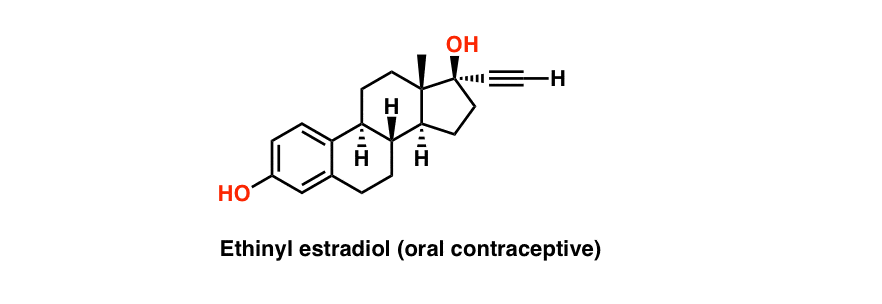
Here, we’re just going to talk about two very simple cases of molecules containing two rings. We’re going to focus our efforts on cyclohexane, and examine in close detail the situation where two cyclohexane rings are bonded to each other in the most common way – with the two ring junctions (“bridgeheads“) on adjacent carbons, a situation we refer to as fused rings.
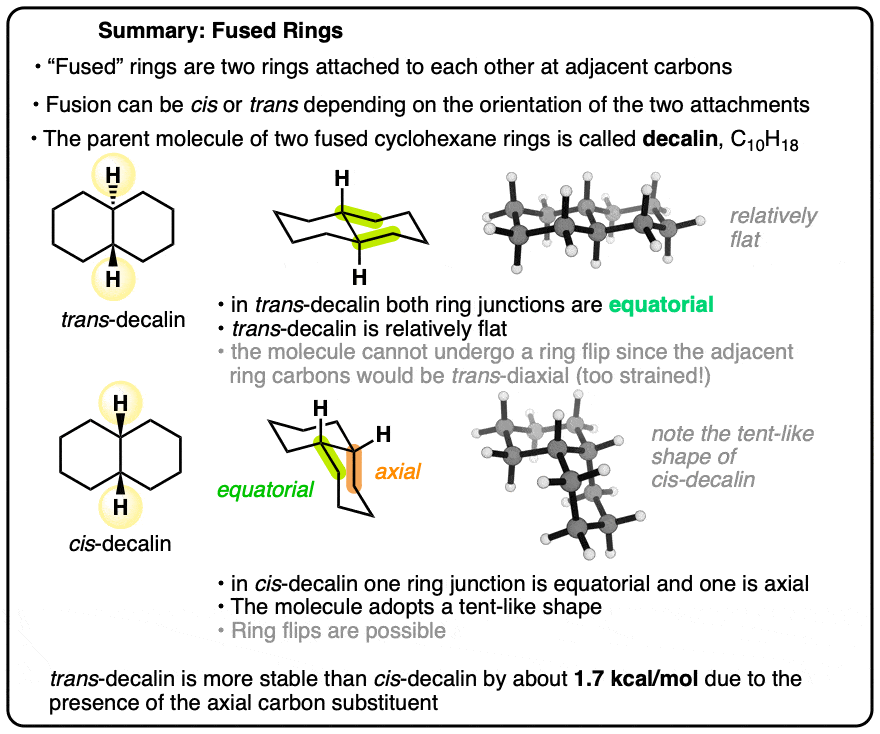
Table of Contents
- cis-Decalin and trans-Decalin
- A Model of cis-Decalin Shows It Has A Tent-Like Shape
- A Model of trans-Decalin Shows It To Be Flat
- Why Is trans-Decalin More Stable Than cis-Decalin? All Carbons Are Equatorial
- cis-Decalin Has Two Gauche Interactions
- Doing A “Ring-Flip” On cis-Decalin
- trans-Decalin Cannot Undergo Ring Flips. It Is Conformationally “Locked”
- Summary: cis-Decalin versus trans-Decalin
- Notes
- (Advanced) References and Further Reading
1. cis-Decalin and trans-Decalin
The parent molecule is called “decalin” since there are ten carbons in total. However, remember that any time we have two substituents on a cyclohexane ring (as we do here), it is essential to draw in the stereochemistry in order to avoid ambiguity! Two stereoisomers are possible here: one where the hydrogens at both ring junctions are “cis”, and the other where they are “trans”.
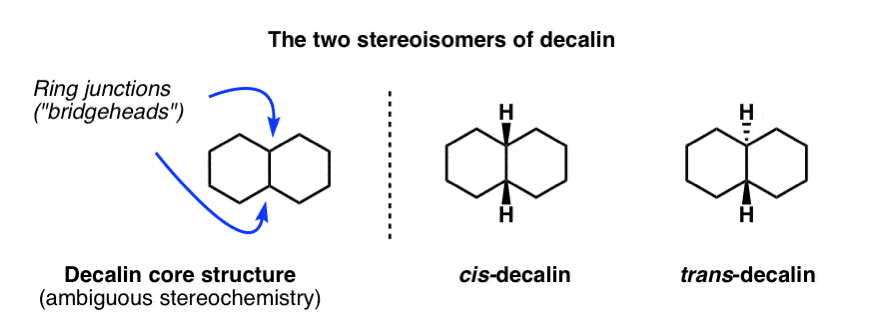 These molecules look so simple when we draw them on paper! What could be simpler than two hexagons joined together?
These molecules look so simple when we draw them on paper! What could be simpler than two hexagons joined together?
Well, just like with cyclohexane itself, the complexity comes when we examine their most stable three-dimensional structures. Each six membered ring will adopt a chair conformation. Believe it or not, the cis and trans stereoisomers of decalin have remarkably different shapes.
There’s no better way to see this than by making a model.
2. A Model Of cis-Decalin Shows It Has A Tent-Like Shape
Here’s cis-decalin. The hydrogens on the “bridgeheads” are highlighted in red and white. Notice how both cyclohexanes are in chair conformations, but the molecule adopts almost a tent-like shape.
3. A Model of trans-Decalin Shows It to Be Flat
And here’s trans-decalin. As we look at the molecule from an angle, it’s obvious that both cyclohexane rings are also in the chair conformation, but the molecule is much flatter overall.
4. Why Is trans-Decalin More Stable than cis-Decalin? All Carbons Are Equatorial
As these movies show, changing the stereochemistry of the bridgehead carbon from a “wedged” H to a “dashed” H can make a huge difference in the overall shape of the molecule!
Let’s look at these two molecules in a bit more detail. First of all, which one should be more stable, cis-decalin or trans-decalin?
First of all, let’s look at line drawings of each of these molecules. When we do so, we notice that in trans-decalin, all carbons are equatorial, whereas in cis-decalin, one carbon is equatorial and the other is axial.
Based on the (safe) assumption that the A-value of the axial group should be about 1.75 kcal/mol, we can therefore make a judgement about the relative stability of these two molecules. 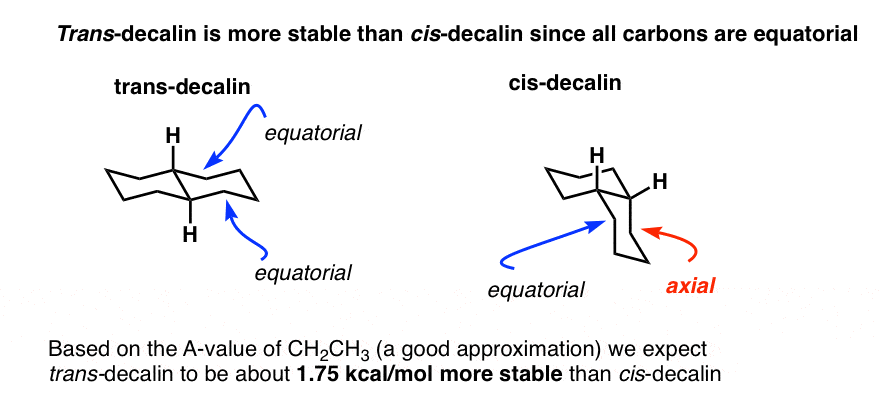
5. cis-Decalin Has Two Gauche Interactions
Just to nail the point home, when we look at cis-decalin from the side, we see the two gauche interactions (each worth about 0.9 kcal/mol) that are responsible for this increase in energy (this is a screenshot of the cis-decalin “flyover” video, above)
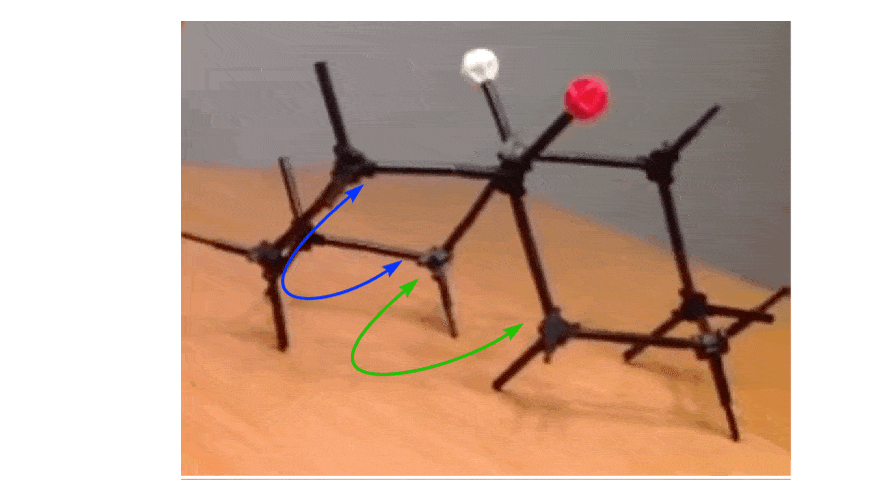
6. Doing A “Ring-Flip” On The cis– Isomer
OK. So we’ve established what cis and trans decalin look like, and which are more stable – but hold on, you might say. What about ring flipping? Does that change anything?
After all, when we do a ring flip on a cyclohexane, all equatorial groups become axial and all axial groups become equatorial. Will this affect any of the relative energies?
Let’s look at cis-decalin first. We have one group equatorial and one group axial. If you said that a ring flip on this molecule would lead to a conformer exactly equal in energy, you are correct!
Here’s a video of the “ring-flip” of cis-decalin in action. Looking at the left-hand cyclohexane, notice how the red (axial) hydrogen becomes equatorial, and the white (equatorial) hydrogen becomes axial. [BTW the cyclohexane on the right is meant to end up looking more like a chair – it turned out a bit flatter than I would have liked]
7. trans-Decalin Cannot Undergo Ring Flips: It Is Conformationally “Locked”
What about trans-decalin? Shouldn’t a ring flip convert both equatorial groups to axial groups, and therefore be higher in energy?
In theory, it’s reasonable to think, “yes” – and in situation where we’re dealing with rings larger than 8 or so, that is what happens. However, this is a prime example of an unexpected consequences I was talking about earlier.
It turns out that a ring flip in trans-decalin isn’t possible because it would lead to too much ring strain. To use an analogy, the reason why trans-decalin can’t do a ring flip is a bit like why you can’t touch your nose to your spine – there just isn’t enough flexibility to do so without putting yourself in tremendous pain.
A different way of saying the same thing is that trans-decalin is locked in position.
So while cis-decalin can undergo ring flips, trans-decalin cannot.

8. Summary: cis-Decalin versus trans-Decalin
In the next post we’ll talk a little bit about some other situations that arise when we have molecules with multiple rings.
Next Post: Bridged Bicyclic Rings
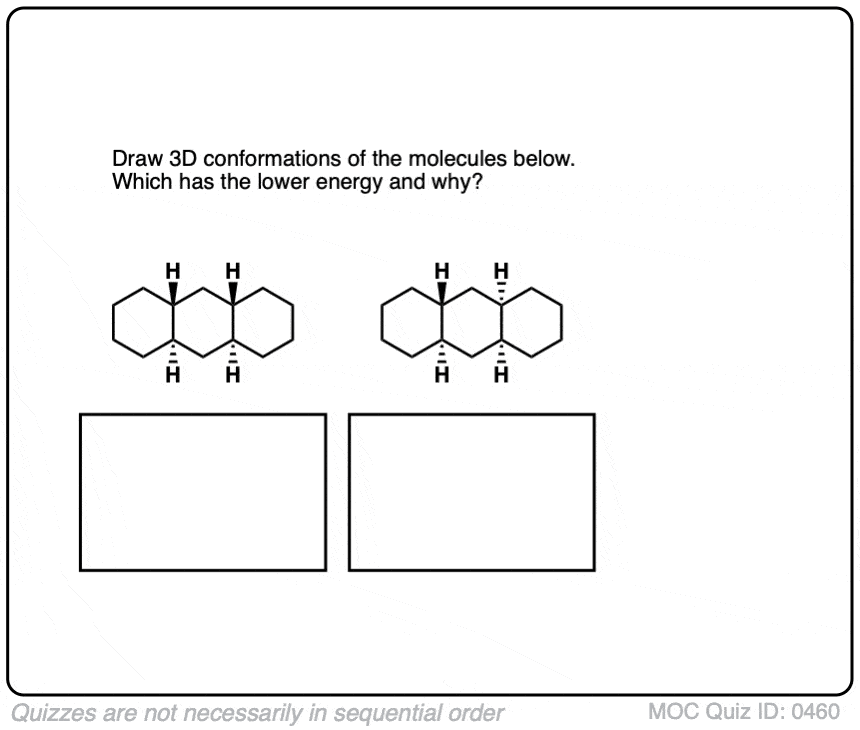 Click to Flip
Click to Flip
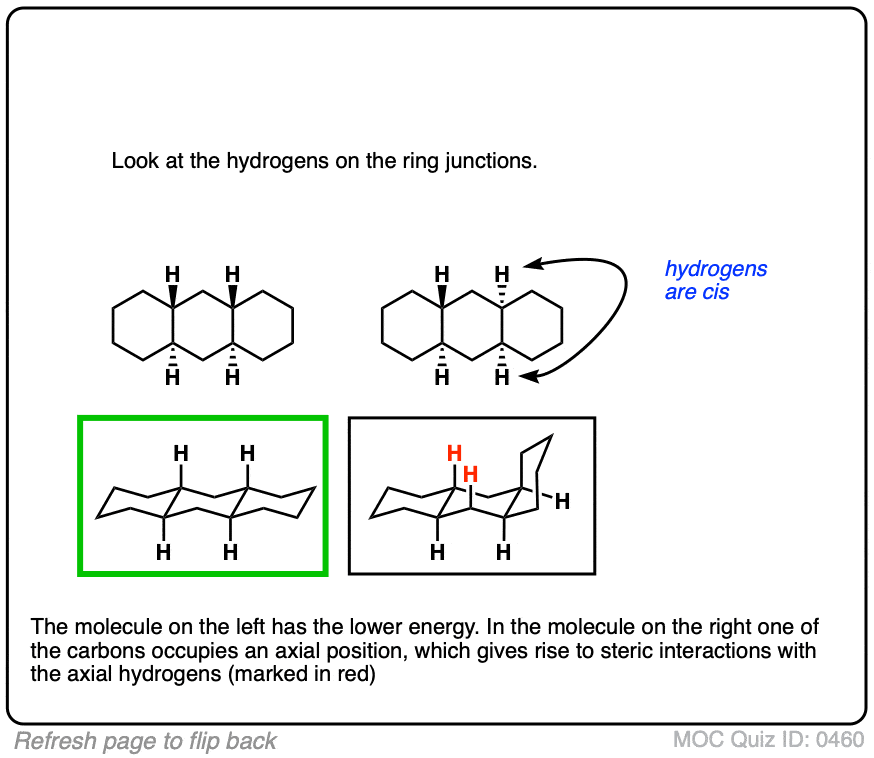
Notes
Related Articles
- Naming Bicyclic Compounds – Fused, Bridged, and Spiro
- Bredt’s Rule (And Summary of Cycloalkanes)
- Cycloalkanes – Ring Strain In Cyclopropane And Cyclobutane
- Substituted Cyclohexanes – Axial vs Equatorial
- Cyclohexane Chair Conformation Stability: Which One Is Lower Energy?
- Cycloalkanes Practice Problems (MOC Membership)
Note 1. The ‘tent-like’ shape of cis decalin (see pic below) has a further important consequence that has been exploited by clever organic chemists for decades. The two faces of cis-decalin are not equivalent. The top face is more “exposed” to the surrounding environment than is the bottom face – in other words, a molecule encounters much less steric hindrance in approaching the top face than it does the bottom face (note how crowded the underside is).

An example will serve to illustrate.
Imagine that we have a decalin with an alkene. There are plenty of useful reactions of alkenes, as we talk about in this series.
To take one example, we can form an epoxide by treating an alkene with a peroxyacid such as m-chloroperoxybenzoic acid.
One example is its reaction with 1-methylcyclohexene, which gives rise to two stereoisomers – enantiomers, in this case [i.e. non-superimposable mirror images] in a 50:50 ratio because both faces of 1-methylcyclohexene are equally accessible. In other words, it is unselective. [I chose 1-methylcyclohexene and not cyclohexene because reaction at either face of cyclohexene gives rise to the same molecule (it has a plane of symmetry) and the issue of selectivity is moot]
If we have a decalin with an alkene, such as the molecule shown below, one face will be more reactive than the other because it is more accessible [in order to react at the bottom face, the peroxyacid would encounter significantly more steric hindrance].
So when we treat this alkene with our peroxyacid, we get a mixture of epoxides that will be selective for one stereoisomer over the other (“stereoselective”). In this case we are forming a mixture of diastereomers, so we say that this reaction is “diastereoselective” (a subclass of “stereoselective”)

For a classic example of how this can be used in target molecule synthesis, see Woodward’s synthesis of reserpine.
Note 2. Some calculations on trans- and cis- decalin, courtesy of Rowan Labs.
Trans-Decalin:
Cis-Decalin
(Advanced) References and Further Reading
- Die Baeyersche Spannungstheorie und die Struktur des Diamanten
Ernst Mohr
Prakt. Chem. 1918, 98 (1), 315-353
DOI: 10.1002/prac.19180980123
Mohr predicted in 1918 that decalin, which has puckered six membered rings, should exist as both cis and trans isomers. - Zur Stereochemie bicyclischer Ringsysteme. I. Die Stereoisomerie des Dekahydronaphthalins und seiner Derivate
Walter Hückel
Lieb. Ann. Chem. 1925, 441 (1), 1-48
DOI: 10.1002/jlac.19254410102
Two planar six membered rings as pictured by Baeyer could only have a cis junction. The pivotal demonstration of the existence of two decalin stereoisomers helped to convince organic chemists that cyclohexane is not planar. The separation of cis and trans decalin by distillation (8 degrees difference) was also achieved, demonstrating that they are two separable, independent compounds. - Physical Chemical Properties of cis- and trans-Decahydronaphthalene
F. Seyer and R. D. Walker
Journal of the American Chemical Society 1938, 60 (9), 2125-2128
DOI: 10.1021/ja01276a028
An early paper rigorously recording and documenting the physical properties of cis and trans-decalin. - The molecular structure of cis- and (trans-bicyclo [4.4.0] decane in the gas phase, studied by electron diffraction and molecular mechanics
Van Den Enden, H. J. Geise, A. Spelbos
J. Mol. Struct. 1978, 44 (2), 177-185
DOI: 10.1016/0022-2860(78)87026-4
A combined theoretical and experimental study of the structures of cis and trans decalin, showing that both cyclohexane rings are in the chair form in both isomers. - Conformational inversion rates in the dimethylcyclohexanes and in some cis-decalins
David M. Grant, Don K. Dalling, and LeRoy F. Johnson
Journal of the American Chemical Society 1971, 93 (15), 3678-3682
DOI: 1021/ja00744a021
For those interested in the power of NMR spectroscopy in structural analysis, this is a very nice paper. Using VT (variable-temperature) 13C NMR, the authors were able to determine that the barrier to ring inversion for cis-decalin is 12.6 kcal/mol at RT. Interestingly, two of the authors are from Varian Associates, one of the pioneers in NMR manufacturing. This paper also came out at the time when NMR technology had just advanced to the point where taking 13C NMRs of unenriched samples was practical. Varian was acquired by Agilent in 2010, and in 2014, Agilent shut down the NMR division of Varian, bringing an end to a chapter in chemical history. - THE TOTAL SYNTHESIS OF RESERPINE
R. B. Woodward, F. E. Bader, H. Bickel, A. J. Frey, and R. W. Kierstead
Journal of the American Chemical Society 1956, 78 (9), 2023-2025
DOI: 10.1021/ja01590a079 - A SIMPLIFIED ROUTE TO A KEY INTERMEDIATE IN THE TOTAL SYNTHESIS OF RESERPINE
R. B. Woodward, F. E. Bader, H. Bickel, A. J. Frey, and R. W. Kierstead
Journal of the American Chemical Society 1956, 78 (11), 2657-2657
DOI: 10.1021/ja01592a102 - The total synthesis of reserpine
R. B. Woodward, F. E. Bader, H. Bickel, A. J. Frey, R. W. Kierstead
Tetrahedron 1958, 2 (1-2), 1-57
DOI: 10.1016/0040-4020(58)88022-9
These three papers are on the total synthesis of reserpine, by the legendary Prof. R. B. Woodward, among the greatest organic chemists of all time. An early Diels-Alder reaction creates the fused ring system with a cis decalin, which is used to set the stereochemistry in the downstream steps.
00 General Chemistry Review
01 Bonding, Structure, and Resonance
- How Do We Know Methane (CH4) Is Tetrahedral?
- Hybrid Orbitals and Hybridization
- How To Determine Hybridization: A Shortcut
- Orbital Hybridization And Bond Strengths
- Sigma bonds come in six varieties: Pi bonds come in one
- A Key Skill: How to Calculate Formal Charge
- The Four Intermolecular Forces and How They Affect Boiling Points
- 3 Trends That Affect Boiling Points
- How To Use Electronegativity To Determine Electron Density (and why NOT to trust formal charge)
- Introduction to Resonance
- How To Use Curved Arrows To Interchange Resonance Forms
- Evaluating Resonance Forms (1) - The Rule of Least Charges
- How To Find The Best Resonance Structure By Applying Electronegativity
- Evaluating Resonance Structures With Negative Charges
- Evaluating Resonance Structures With Positive Charge
- Exploring Resonance: Pi-Donation
- Exploring Resonance: Pi-acceptors
- In Summary: Evaluating Resonance Structures
- Drawing Resonance Structures: 3 Common Mistakes To Avoid
- How to apply electronegativity and resonance to understand reactivity
- Bond Hybridization Practice
- Structure and Bonding Practice Quizzes
- Resonance Structures Practice
02 Acid Base Reactions
- Introduction to Acid-Base Reactions
- Acid Base Reactions In Organic Chemistry
- The Stronger The Acid, The Weaker The Conjugate Base
- Walkthrough of Acid-Base Reactions (3) - Acidity Trends
- Five Key Factors That Influence Acidity
- Acid-Base Reactions: Introducing Ka and pKa
- How to Use a pKa Table
- The pKa Table Is Your Friend
- A Handy Rule of Thumb for Acid-Base Reactions
- Acid Base Reactions Are Fast
- pKa Values Span 60 Orders Of Magnitude
- How Protonation and Deprotonation Affect Reactivity
- Acid Base Practice Problems
03 Alkanes and Nomenclature
- Meet the (Most Important) Functional Groups
- Condensed Formulas: Deciphering What the Brackets Mean
- Hidden Hydrogens, Hidden Lone Pairs, Hidden Counterions
- Don't Be Futyl, Learn The Butyls
- Primary, Secondary, Tertiary, Quaternary In Organic Chemistry
- Branching, and Its Affect On Melting and Boiling Points
- The Many, Many Ways of Drawing Butane
- Wedge And Dash Convention For Tetrahedral Carbon
- Common Mistakes in Organic Chemistry: Pentavalent Carbon
- Table of Functional Group Priorities for Nomenclature
- Summary Sheet - Alkane Nomenclature
- Organic Chemistry IUPAC Nomenclature Demystified With A Simple Puzzle Piece Approach
- Boiling Point Quizzes
- Organic Chemistry Nomenclature Quizzes
04 Conformations and Cycloalkanes
- Staggered vs Eclipsed Conformations of Ethane
- Conformational Isomers of Propane
- Newman Projection of Butane (and Gauche Conformation)
- Introduction to Cycloalkanes
- Geometric Isomers In Small Rings: Cis And Trans Cycloalkanes
- Calculation of Ring Strain In Cycloalkanes
- Cycloalkanes - Ring Strain In Cyclopropane And Cyclobutane
- Cyclohexane Conformations
- Cyclohexane Chair Conformation: An Aerial Tour
- How To Draw The Cyclohexane Chair Conformation
- The Cyclohexane Chair Flip
- The Cyclohexane Chair Flip - Energy Diagram
- Substituted Cyclohexanes - Axial vs Equatorial
- Ranking The Bulkiness Of Substituents On Cyclohexanes: "A-Values"
- Cyclohexane Chair Conformation Stability: Which One Is Lower Energy?
- Fused Rings - Cis-Decalin and Trans-Decalin
- Naming Bicyclic Compounds - Fused, Bridged, and Spiro
- Bredt's Rule (And Summary of Cycloalkanes)
- Newman Projection Practice
- Cycloalkanes Practice Problems
05 A Primer On Organic Reactions
- The Most Important Question To Ask When Learning a New Reaction
- Curved Arrows (for reactions)
- Nucleophiles and Electrophiles
- The Three Classes of Nucleophiles
- Nucleophilicity vs. Basicity
- What Makes A Good Nucleophile?
- What Makes A Good Leaving Group?
- 3 Factors That Stabilize Carbocations
- Equilibrium and Energy Relationships
- 7 Factors that stabilize negative charge in organic chemistry
- 7 Factors That Stabilize Positive Charge in Organic Chemistry
- What's a Transition State?
- Hammond's Postulate
- Learning Organic Chemistry Reactions: A Checklist (PDF)
- Introduction to Oxidative Cleavage Reactions
06 Free Radical Reactions
- Bond Dissociation Energies = Homolytic Cleavage
- Free Radical Reactions
- 3 Factors That Stabilize Free Radicals
- What Factors Destabilize Free Radicals?
- Bond Strengths And Radical Stability
- Free Radical Initiation: Why Is "Light" Or "Heat" Required?
- Initiation, Propagation, Termination
- Monochlorination Products Of Propane, Pentane, And Other Alkanes
- Selectivity In Free Radical Reactions
- Selectivity in Free Radical Reactions: Bromination vs. Chlorination
- Halogenation At Tiffany's
- Allylic Bromination
- Bonus Topic: Allylic Rearrangements
- In Summary: Free Radicals
- Synthesis (2) - Reactions of Alkanes
- Free Radicals Practice Quizzes
07 Stereochemistry and Chirality
- Types of Isomers: Constitutional Isomers, Stereoisomers, Enantiomers, and Diastereomers
- How To Draw The Enantiomer Of A Chiral Molecule
- How To Draw A Bond Rotation
- Introduction to Assigning (R) and (S): The Cahn-Ingold-Prelog Rules
- Assigning Cahn-Ingold-Prelog (CIP) Priorities (2) - The Method of Dots
- Enantiomers vs Diastereomers vs The Same? Two Methods For Solving Problems
- Assigning R/S To Newman Projections (And Converting Newman To Line Diagrams)
- How To Determine R and S Configurations On A Fischer Projection
- The Meso Trap
- Optical Rotation, Optical Activity, and Specific Rotation
- Optical Purity and Enantiomeric Excess
- What's a Racemic Mixture?
- Chiral Allenes And Chiral Axes
- Stereochemistry Practice Problems and Quizzes
08 Substitution Reactions
- Nucleophilic Substitution Reactions - Introduction
- Two Types of Nucleophilic Substitution Reactions
- The SN2 Mechanism
- Why the SN2 Reaction Is Powerful
- The SN1 Mechanism
- The Conjugate Acid Is A Better Leaving Group
- Comparing the SN1 and SN2 Reactions
- Polar Protic? Polar Aprotic? Nonpolar? All About Solvents
- Steric Hindrance is Like a Fat Goalie
- Common Blind Spot: Intramolecular Reactions
- Substitution Practice - SN1
- Substitution Practice - SN2
09 Elimination Reactions
- Elimination Reactions (1): Introduction And The Key Pattern
- Elimination Reactions (2): The Zaitsev Rule
- Elimination Reactions Are Favored By Heat
- Two Elimination Reaction Patterns
- The E1 Reaction
- The E2 Mechanism
- E1 vs E2: Comparing the E1 and E2 Reactions
- Antiperiplanar Relationships: The E2 Reaction and Cyclohexane Rings
- Bulky Bases in Elimination Reactions
- Comparing the E1 vs SN1 Reactions
- Elimination (E1) Reactions With Rearrangements
- E1cB - Elimination (Unimolecular) Conjugate Base
- Elimination (E1) Practice Problems And Solutions
- Elimination (E2) Practice Problems and Solutions
10 Rearrangements
11 SN1/SN2/E1/E2 Decision
- Identifying Where Substitution and Elimination Reactions Happen
- Deciding SN1/SN2/E1/E2 (1) - The Substrate
- Deciding SN1/SN2/E1/E2 (2) - The Nucleophile/Base
- SN1 vs E1 and SN2 vs E2 : The Temperature
- Deciding SN1/SN2/E1/E2 - The Solvent
- Wrapup: The Key Factors For Determining SN1/SN2/E1/E2
- Alkyl Halide Reaction Map And Summary
- SN1 SN2 E1 E2 Practice Problems
12 Alkene Reactions
- E and Z Notation For Alkenes (+ Cis/Trans)
- Alkene Stability
- Alkene Addition Reactions: "Regioselectivity" and "Stereoselectivity" (Syn/Anti)
- Stereoselective and Stereospecific Reactions
- Hydrohalogenation of Alkenes and Markovnikov's Rule
- Hydration of Alkenes With Aqueous Acid
- Rearrangements in Alkene Addition Reactions
- Halogenation of Alkenes and Halohydrin Formation
- Oxymercuration Demercuration of Alkenes
- Hydroboration Oxidation of Alkenes
- m-CPBA (meta-chloroperoxybenzoic acid)
- OsO4 (Osmium Tetroxide) for Dihydroxylation of Alkenes
- Palladium on Carbon (Pd/C) for Catalytic Hydrogenation of Alkenes
- Cyclopropanation of Alkenes
- A Fourth Alkene Addition Pattern - Free Radical Addition
- Alkene Reactions: Ozonolysis
- Summary: Three Key Families Of Alkene Reaction Mechanisms
- Synthesis (4) - Alkene Reaction Map, Including Alkyl Halide Reactions
- Alkene Reactions Practice Problems
13 Alkyne Reactions
- Acetylides from Alkynes, And Substitution Reactions of Acetylides
- Partial Reduction of Alkynes With Lindlar's Catalyst
- Partial Reduction of Alkynes With Na/NH3 To Obtain Trans Alkenes
- Alkyne Hydroboration With "R2BH"
- Hydration and Oxymercuration of Alkynes
- Hydrohalogenation of Alkynes
- Alkyne Halogenation: Bromination and Chlorination of Alkynes
- Alkyne Reactions - The "Concerted" Pathway
- Alkenes To Alkynes Via Halogenation And Elimination Reactions
- Alkynes Are A Blank Canvas
- Synthesis (5) - Reactions of Alkynes
- Alkyne Reactions Practice Problems With Answers
14 Alcohols, Epoxides and Ethers
- Alcohols - Nomenclature and Properties
- Alcohols Can Act As Acids Or Bases (And Why It Matters)
- Alcohols - Acidity and Basicity
- The Williamson Ether Synthesis
- Ethers From Alkenes, Tertiary Alkyl Halides and Alkoxymercuration
- Alcohols To Ethers via Acid Catalysis
- Cleavage Of Ethers With Acid
- Epoxides - The Outlier Of The Ether Family
- Opening of Epoxides With Acid
- Epoxide Ring Opening With Base
- Making Alkyl Halides From Alcohols
- Tosylates And Mesylates
- PBr3 and SOCl2
- Elimination Reactions of Alcohols
- Elimination of Alcohols To Alkenes With POCl3
- Alcohol Oxidation: "Strong" and "Weak" Oxidants
- Demystifying The Mechanisms of Alcohol Oxidations
- Protecting Groups For Alcohols
- Thiols And Thioethers
- Calculating the oxidation state of a carbon
- Oxidation and Reduction in Organic Chemistry
- Oxidation Ladders
- SOCl2 Mechanism For Alcohols To Alkyl Halides: SN2 versus SNi
- Alcohol Reactions Roadmap (PDF)
- Alcohol Reaction Practice Problems
- Epoxide Reaction Quizzes
- Oxidation and Reduction Practice Quizzes
15 Organometallics
- What's An Organometallic?
- Formation of Grignard and Organolithium Reagents
- Organometallics Are Strong Bases
- Reactions of Grignard Reagents
- Protecting Groups In Grignard Reactions
- Synthesis Problems Involving Grignard Reagents
- Grignard Reactions And Synthesis (2)
- Organocuprates (Gilman Reagents): How They're Made
- Gilman Reagents (Organocuprates): What They're Used For
- The Heck, Suzuki, and Olefin Metathesis Reactions (And Why They Don't Belong In Most Introductory Organic Chemistry Courses)
- Reaction Map: Reactions of Organometallics
- Grignard Practice Problems
16 Spectroscopy
- Degrees of Unsaturation (or IHD, Index of Hydrogen Deficiency)
- Conjugation And Color (+ How Bleach Works)
- Introduction To UV-Vis Spectroscopy
- UV-Vis Spectroscopy: Absorbance of Carbonyls
- UV-Vis Spectroscopy: Practice Questions
- Bond Vibrations, Infrared Spectroscopy, and the "Ball and Spring" Model
- Infrared Spectroscopy: A Quick Primer On Interpreting Spectra
- IR Spectroscopy: 4 Practice Problems
- 1H NMR: How Many Signals?
- Homotopic, Enantiotopic, Diastereotopic
- Diastereotopic Protons in 1H NMR Spectroscopy: Examples
- 13-C NMR - How Many Signals
- Liquid Gold: Pheromones In Doe Urine
- Natural Product Isolation (1) - Extraction
- Natural Product Isolation (2) - Purification Techniques, An Overview
- Structure Determination Case Study: Deer Tarsal Gland Pheromone
17 Dienes and MO Theory
- What To Expect In Organic Chemistry 2
- Are these molecules conjugated?
- Conjugation And Resonance In Organic Chemistry
- Bonding And Antibonding Pi Orbitals
- Molecular Orbitals of The Allyl Cation, Allyl Radical, and Allyl Anion
- Pi Molecular Orbitals of Butadiene
- Reactions of Dienes: 1,2 and 1,4 Addition
- Thermodynamic and Kinetic Products
- More On 1,2 and 1,4 Additions To Dienes
- s-cis and s-trans
- The Diels-Alder Reaction
- Cyclic Dienes and Dienophiles in the Diels-Alder Reaction
- Stereochemistry of the Diels-Alder Reaction
- Exo vs Endo Products In The Diels Alder: How To Tell Them Apart
- HOMO and LUMO In the Diels Alder Reaction
- Why Are Endo vs Exo Products Favored in the Diels-Alder Reaction?
- Diels-Alder Reaction: Kinetic and Thermodynamic Control
- The Retro Diels-Alder Reaction
- The Intramolecular Diels Alder Reaction
- Regiochemistry In The Diels-Alder Reaction
- The Cope and Claisen Rearrangements
- Electrocyclic Reactions
- Electrocyclic Ring Opening And Closure (2) - Six (or Eight) Pi Electrons
- Diels Alder Practice Problems
- Molecular Orbital Theory Practice
18 Aromaticity
- Introduction To Aromaticity
- Rules For Aromaticity
- Huckel's Rule: What Does 4n+2 Mean?
- Aromatic, Non-Aromatic, or Antiaromatic? Some Practice Problems
- Antiaromatic Compounds and Antiaromaticity
- The Pi Molecular Orbitals of Benzene
- The Pi Molecular Orbitals of Cyclobutadiene
- Frost Circles
- Aromaticity Practice Quizzes
19 Reactions of Aromatic Molecules
- Electrophilic Aromatic Substitution: Introduction
- Activating and Deactivating Groups In Electrophilic Aromatic Substitution
- Electrophilic Aromatic Substitution - The Mechanism
- Ortho-, Para- and Meta- Directors in Electrophilic Aromatic Substitution
- Understanding Ortho, Para, and Meta Directors
- Why are halogens ortho- para- directors?
- Disubstituted Benzenes: The Strongest Electron-Donor "Wins"
- Electrophilic Aromatic Substitutions (1) - Halogenation of Benzene
- Electrophilic Aromatic Substitutions (2) - Nitration and Sulfonation
- EAS Reactions (3) - Friedel-Crafts Acylation and Friedel-Crafts Alkylation
- Intramolecular Friedel-Crafts Reactions
- Nucleophilic Aromatic Substitution (NAS)
- Nucleophilic Aromatic Substitution (2) - The Benzyne Mechanism
- Reactions on the "Benzylic" Carbon: Bromination And Oxidation
- The Wolff-Kishner, Clemmensen, And Other Carbonyl Reductions
- More Reactions on the Aromatic Sidechain: Reduction of Nitro Groups and the Baeyer Villiger
- Aromatic Synthesis (1) - "Order Of Operations"
- Synthesis of Benzene Derivatives (2) - Polarity Reversal
- Aromatic Synthesis (3) - Sulfonyl Blocking Groups
- Birch Reduction
- Synthesis (7): Reaction Map of Benzene and Related Aromatic Compounds
- Aromatic Reactions and Synthesis Practice
- Electrophilic Aromatic Substitution Practice Problems
20 Aldehydes and Ketones
- What's The Alpha Carbon In Carbonyl Compounds?
- Nucleophilic Addition To Carbonyls
- Aldehydes and Ketones: 14 Reactions With The Same Mechanism
- Sodium Borohydride (NaBH4) Reduction of Aldehydes and Ketones
- Grignard Reagents For Addition To Aldehydes and Ketones
- Wittig Reaction
- Hydrates, Hemiacetals, and Acetals
- Imines - Properties, Formation, Reactions, and Mechanisms
- All About Enamines
- Breaking Down Carbonyl Reaction Mechanisms: Reactions of Anionic Nucleophiles (Part 2)
- Aldehydes Ketones Reaction Practice
21 Carboxylic Acid Derivatives
- Nucleophilic Acyl Substitution (With Negatively Charged Nucleophiles)
- Addition-Elimination Mechanisms With Neutral Nucleophiles (Including Acid Catalysis)
- Basic Hydrolysis of Esters - Saponification
- Transesterification
- Proton Transfer
- Fischer Esterification - Carboxylic Acid to Ester Under Acidic Conditions
- Lithium Aluminum Hydride (LiAlH4) For Reduction of Carboxylic Acid Derivatives
- LiAlH[Ot-Bu]3 For The Reduction of Acid Halides To Aldehydes
- Di-isobutyl Aluminum Hydride (DIBAL) For The Partial Reduction of Esters and Nitriles
- Amide Hydrolysis
- Thionyl Chloride (SOCl2) And Conversion of Carboxylic Acids to Acid Halides
- Diazomethane (CH2N2)
- Carbonyl Chemistry: Learn Six Mechanisms For the Price Of One
- Making Music With Mechanisms (PADPED)
- Carboxylic Acid Derivatives Practice Questions
22 Enols and Enolates
- Keto-Enol Tautomerism
- Enolates - Formation, Stability, and Simple Reactions
- Kinetic Versus Thermodynamic Enolates
- Aldol Addition and Condensation Reactions
- Reactions of Enols - Acid-Catalyzed Aldol, Halogenation, and Mannich Reactions
- Claisen Condensation and Dieckmann Condensation
- Decarboxylation
- The Malonic Ester and Acetoacetic Ester Synthesis
- The Michael Addition Reaction and Conjugate Addition
- The Robinson Annulation
- Haloform Reaction
- The Hell–Volhard–Zelinsky Reaction
- Enols and Enolates Practice Quizzes
23 Amines
- The Amide Functional Group: Properties, Synthesis, and Nomenclature
- Basicity of Amines And pKaH
- 5 Key Basicity Trends of Amines
- The Mesomeric Effect And Aromatic Amines
- Nucleophilicity of Amines
- Alkylation of Amines (Sucks!)
- Reductive Amination
- The Gabriel Synthesis
- Some Reactions of Azides
- The Hofmann Elimination
- The Hofmann and Curtius Rearrangements
- The Cope Elimination
- Protecting Groups for Amines - Carbamates
- The Strecker Synthesis of Amino Acids
- Introduction to Peptide Synthesis
- Reactions of Diazonium Salts: Sandmeyer and Related Reactions
- Amine Practice Questions
24 Carbohydrates
- D and L Notation For Sugars
- Pyranoses and Furanoses: Ring-Chain Tautomerism In Sugars
- What is Mutarotation?
- Reducing Sugars
- The Big Damn Post Of Carbohydrate-Related Chemistry Definitions
- The Haworth Projection
- Converting a Fischer Projection To A Haworth (And Vice Versa)
- Reactions of Sugars: Glycosylation and Protection
- The Ruff Degradation and Kiliani-Fischer Synthesis
- Isoelectric Points of Amino Acids (and How To Calculate Them)
- Carbohydrates Practice
- Amino Acid Quizzes
25 Fun and Miscellaneous
- A Gallery of Some Interesting Molecules From Nature
- Screw Organic Chemistry, I'm Just Going To Write About Cats
- On Cats, Part 1: Conformations and Configurations
- On Cats, Part 2: Cat Line Diagrams
- On Cats, Part 4: Enantiocats
- On Cats, Part 6: Stereocenters
- Organic Chemistry Is Shit
- The Organic Chemistry Behind "The Pill"
- Maybe they should call them, "Formal Wins" ?
- Why Do Organic Chemists Use Kilocalories?
- The Principle of Least Effort
- Organic Chemistry GIFS - Resonance Forms
- Reproducibility In Organic Chemistry
- What Holds The Nucleus Together?
- How Reactions Are Like Music
- Organic Chemistry and the New MCAT
26 Organic Chemistry Tips and Tricks
- Common Mistakes: Formal Charges Can Mislead
- Partial Charges Give Clues About Electron Flow
- Draw The Ugly Version First
- Organic Chemistry Study Tips: Learn the Trends
- The 8 Types of Arrows In Organic Chemistry, Explained
- Top 10 Skills To Master Before An Organic Chemistry 2 Final
- Common Mistakes with Carbonyls: Carboxylic Acids... Are Acids!
- Planning Organic Synthesis With "Reaction Maps"
- Alkene Addition Pattern #1: The "Carbocation Pathway"
- Alkene Addition Pattern #2: The "Three-Membered Ring" Pathway
- Alkene Addition Pattern #3: The "Concerted" Pathway
- Number Your Carbons!
- The 4 Major Classes of Reactions in Org 1
- How (and why) electrons flow
- Grossman's Rule
- Three Exam Tips
- A 3-Step Method For Thinking Through Synthesis Problems
- Putting It Together
- Putting Diels-Alder Products in Perspective
- The Ups and Downs of Cyclohexanes
- The Most Annoying Exceptions in Org 1 (Part 1)
- The Most Annoying Exceptions in Org 1 (Part 2)
- The Marriage May Be Bad, But the Divorce Still Costs Money
- 9 Nomenclature Conventions To Know
- Nucleophile attacks Electrophile
27 Case Studies of Successful O-Chem Students
- Success Stories: How Corina Got The The "Hard" Professor - And Got An A+ Anyway
- How Helena Aced Organic Chemistry
- From a "Drop" To B+ in Org 2 – How A Hard Working Student Turned It Around
- How Serge Aced Organic Chemistry
- Success Stories: How Zach Aced Organic Chemistry 1
- Success Stories: How Kari Went From C– to B+
- How Esther Bounced Back From a "C" To Get A's In Organic Chemistry 1 And 2
- How Tyrell Got The Highest Grade In Her Organic Chemistry Course
- This Is Why Students Use Flashcards
- Success Stories: How Stu Aced Organic Chemistry
- How John Pulled Up His Organic Chemistry Exam Grades
- Success Stories: How Nathan Aced Organic Chemistry (Without It Taking Over His Life)
- How Chris Aced Org 1 and Org 2
- Interview: How Jay Got an A+ In Organic Chemistry
- How to Do Well in Organic Chemistry: One Student's Advice
- "America's Top TA" Shares His Secrets For Teaching O-Chem
- "Organic Chemistry Is Like..." - A Few Metaphors
- How To Do Well In Organic Chemistry: Advice From A Tutor
- Guest post: "I went from being afraid of tests to actually looking forward to them".
For instability of cis-decalin, you have mentioned that there are two gauche interactions. How many gauche interactions are there in trans-decalin? When I drew the Newman projections, there are 3 gauche interactions in cis and 2 are in trans. But I may be wrong.
What shape would a trans decalin be that had a double bond opposite where the rings fuse? And would this have an impact on epoxide formation (using a peroxide) and subsequent reduction of the epoxide to an alcohol?
I’m not sure which trans decalin alkene you’re referring to, but to answer your second question, opening of epoxides happens in a very specific way – it occurs so that both substituents will end up axial so the half-chair can relax into a boat. It’s called the Furst-Plattner rule. https://en.wikipedia.org/wiki/F%C3%BCrst-Plattner_Rule
I have the same modeling kit.
How did you connect the middle carbons ( the carbons that create the bridge) in a cis confirmation?
Remember that when two adjacent substituents on a ring are “cis”, one is axial and the other is equatorial. Takes some time to get used to, but they are on the same side!
It’s completely explained topic in best way. Thanks
Glad to hear, thank you for stopping by, Komal.
Thank you! This is wonderfully helpful!
I was wondering what model kit you use. They look easy to manipulate bonds around.
Thanks!
They are Darling models. https://www.darlingmodels.com/index.php?dm=true
Bro the video doesn’t help.
In cis decalin having one methyl group substitution which conformer is more stable?
Where are you putting the methyl group?
If you drew a chair and a flipped chair connected together would that also be a trans decalin? Also would another reason that trans is more stable is that the methyl groups are going in different directions (one in and one out) so there is less interaction when compared to the cis decalin?
I’m assuming you’re talking about the isomer of dimethyl decalin where there are methyl groups on the ring junctions. Yes, with cis decalin those methyl groups would have a dihedral angle of 60 degrees to each other (staggered) whereas in trans decalin they would be staggered.